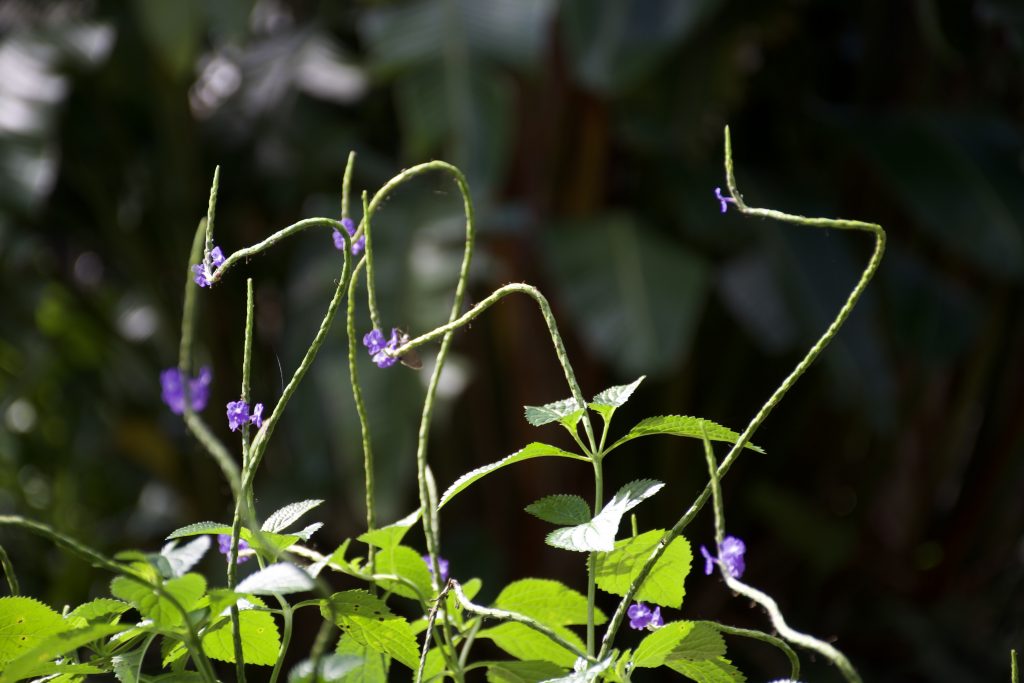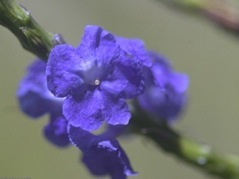
Tall Blue Porter Weed. Photo by Green Deane
Stachytarpheta jamaicensis: Near Beer
Should the civilized world come to an end and you have a hankering for a stout beer you’re in luck: You can make one from the Blue Porterweed, Stachytarpheta jamaicensis. And if a beer is not to your liking, then you can make it into a tea with a beer-like foam.
Porter is a dark brown beer on the bitter side. A stout is a strong porter. Porter’s Beer, Porter’s Ale, Porter House Steaks all go back to shops that serviced porters and laborers in England as early as the early 1700’s. The Central American brew made with the Blue Porterweed got its name by the dark color and bitter flavor of that ancient ale.
The tea side of the Blue Porterweed is better known. It was once exported from Brazil as Brazilian Tea and was also used to stretch “Chinese” tea. In fact it is still used in Brazil today. It is drank for taste or medicinally.
Beer and tea is not the plant’s only claim to fame, besides a long list of herbal uses (see the herb blurb below.) It is a mainstay of almost every butterfly garden. Because of the plant’s growth habit of sending up a spike that then flowers out continuously it is butterfly fast food. Attracted to it are skippers, viceroys, monarchs, and queens, among many.
Stachytarpheta is from the Greek words stachys meaning spike and tarphys which means thick or dense. This is reference to the flower spike. How that is said is a bit of debate. In Latin they say steak-ee-tar-FEE-tuh. In Greek, which is what the words are, the first “A” would be short: stah-ee-tar-FEE-tuh. Jamaicensis means of Jamaica — read Caribbean — and is said jah-may-CEN-sis. At any rate some think it got to Florida around 1700 from Jamaica and then butterfly gardens around the world.
How did they make the beer? No one seems to report that. The way to do it is make a tea of suitable taste and then add sugar and yeast, which is how the soft drink Root Beer started out, as root tea.
I learned from my good friend Ryan (husband of forager Sunny Savage and good friends of mine) that the blossoms taste like mushrooms. And they do! Delicately so. I’ve never found a reference for said but Ryan said they ate them in Hawaii where he grew up. I’ve tried them. Tasty and quite surprising.
A few words of caution: Don’t mistake Vervain, Verbena Officinalis, which has some edible parts, for Blue Porterweed. There is some resemblance but Vervain branches more freely, has plump bloom tips and the leaves are more lance shaped whereas the Blue Porterweed tends to have oval leaves, less branching, and has a long skinny flowering tip that is skinny to the end. Stachytarpheta urticifolia was historically used in Bangladesh to induce abortions. Research with mice in 2004 confirmed that effect.
Green Deane’s “Itemized” Plant Profile
IDENTIFICATION:
A low shrub that trails on the ground, tips rising up, no taller than a yard, usually much less, one or two feet, stems angled, leaves opposite, oval to lance shaped, dark green one to four inches long, edges distinctly toothed. Five petal blue flowers grow on a spike, a few at a time opening only one day. There are several related species: Remember, it is a short plant with blue flowers. If it came from a nursery it is probably NOT the right plant.
TIME OF YEAR:
Year round, spring to fall in more northern climes.
ENVIRONMENT:
Sand dunes to pine forests to scrub land and even occasionally wetlands. Naturalized in Florida, Alabama, Hawaii and Puerto Rico. Found in seasonal flower gardens
METHOD OF PREPARATION:
Dry the leaves, use like Chinese tea, or brew beer, blossoms as a trail side nibble. You can also use the spikes as a flavoring ingredient like a bay leaf.
HERB BLURB
2003 Abstract: The anti-oxidant effects of ethyl acetate (EAcE) and n-hexane extracts (nHE) of dried leaves of Stachytarpheta jamaicensis Vahl. (Verbenaceae) on the reactive oxygen species (ROS) generating during the respiratory burst of rat peritoneal macrophages were investigated. Only EAcE, at concentrations between 0.4 and 40 µg/ml, inhibited the extracellular release of oxygen radicals by resident peritoneal macrophages stimulated with phorbol-12-myristate 13-acetate (PMA). At concentrations above 40 µg/ml, EAcE inhibited the production of nitric oxide (NO) in macrophages stimulated in vivo with sodium thioglycollate then in vitro with lipopolysaccharide (LPS) and gamma-interferon (IFN-). nHE extracts at concentrations between 0.4 and 40 µg/ml did not scavenge O-2 generated enzymatically by hypoxanthine/xanthine oxidase (HX/XO) system, but EAcE at the same concentrations showed potent O-2-scavenging activity. At 40 µg/ml, EAcE also inhibited XO activity. These results suggest that the EAcE extract of S. jamaicensis may be a potential pharmaceutical value in treatment of immunopathological diseases related to oxidative stress.



Does blue porterweed grow in zone 7? If so, where might I get some for my garden? BTW, I tried posting this to the forum but was unable to register and don’t see an email contact option on the website. Thanks.
It will in the summer time.
If you are still looking for it, they had it at Petals from the Past in Jemison, AL several years ago.
I have too many of those flowers here, What would happen if I eat a bunch of like 30 flowers? would you recommend??
Too many? How can one have too many? Eat a few at a time, not 30.
Great episode and video! I have a porterweed of another color (coral to be exact) growing in my yard. Is there any reason you specified the blue only?
Blue is the only one I have eaten thus the only one I know is safe.
I had just gotten a blue porterweed plant that was mistakenly identified as blue vervain. Thank you for the information. I’m still uncertain as to this plants medicinal value.
It comes by many names including blue porterweed, blue snake weed, blue vervain, Brazilian tea, Jamaica vervain, and light-blue snakeweed.
These plants grow abundantly here in the pacific islands. I was trying to figure out what the plant was and if it was edible. The young leaves resemble stinging nettle leaves. I took a little nibble and had no side-effects…What do you know about the leaves – have you used them other than dried in teas? (ie. salads or sauteed) They have such a beautiful deep green colour – I just know they’re bursting with nutrients!!
First saw this plant in Miami along the roadside. It was intriguing, so I examined it a bit and found it had an aroma that hinted of mushrooms with metallic overtones. I wish i knew then what you’ve written, and I would have saved seeds. Also, I’ve seen plants for sale in nurseries that are labeled “Porterweed,” but their foliage has no odor at all, so I doubt they would have the same properties.
I tried thiis using leaves and flowers for arthric pain It helped in 20 min. Highly recommed it. It has a nice flavor
Both the blue low native and the tall blue non-native are good to use.
Stachytarpheta jamaicensis is a native to Florida. It goes wild in Hillsboro, Osceola, Brevard counties and south all year round. It grows like a ground cover, close to the ground. Naturalized refers to non-natives (exotics) that can grow well outside their native range and will extend themselves outside your garden. They never become native. Stachytarpheta cayennensis is a non-native (exotic) variety that grows upright. This is a category II invasive, so should not be planted because it’s harmful to our natural areas.
Yes they DO taste like delicate mushrooms. I can’t remember who taught me that but I’ve been eating them ever since!
As that information originated with this website it has to come from here.
I have a few of the taller species growing in my garden. I figured they are growing upright because I used a stake to support it’s wood like stalk. Nevertheless, before a few days ago I had no idea what they were good for. Somehow came across the image on offer up from someone selling the plant. That led me to google, then YouTube, then back to google. After 48 hrs of research. I took some stems(leaves and flowers included) dried them and made a nice tea. It was very calming. I felt like I smoked a joint but without the high. Just really mellow, clear, and mentally calm and positive. So If you have a bunch of these I my advice would be to sell them as teas.
This herb is very effective
I take this as my medicine
This freaked me out!
Seeing the medicinal curing properties in blue porter-weed, I ate 3-4 flowers off the plant. I got up and decided to go boil some water.
I got into the kitchen , found my wife there finishing off a chicken stir-fry dish.
I washed about 5-6 leaves under cold water and snipped it to small pieces and mixed it with my plate of food and ate it..
THEN I saw the warnings of not eating the leaves raw!
Now 30 minutes later, I am thinking, ok, it was a low dosage….
I will let you know.